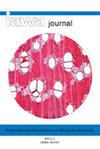用砂表面代替载玻片的木材光学显微镜
IF 3.5
3区 农林科学
Q2 FORESTRY
引用次数: 2
摘要
木质部解剖学是陆地植物进化、树木生态生理学、林业和木材科学研究的基础。传统的木质部解剖研究是利用木材切片进行的。然而,这一过程很费力,从难降解的木材和干燥的木材材料中获得高质量的组织学切片尤其具有挑战性。现代显微镜为加快木质部解剖准备提供了机会。在这方面,使用砂纸表面进行木材解剖研究的优点在很大程度上被忽视了。在树木年表和木材鉴定研究中,对木材表面进行打磨,专门用于研究宏观特征,如树木年轮、木材孔隙度或薄壁组织模式。我们通过反射白光和落射荧光显微镜对难以切割的高密度木材(如Dalbergia和Quercus)的砂磨表面进行了微观研究。反射白光或反射光与荧光的结合可以清楚地显示出砂磨木材表面木质部的微观特征。用1000砂砾打磨后细胞类型的分辨率与通过透射光显微镜在组织切片中获得的分辨率相似。与传统木材切片相比,砂磨木材表面的优势可以概括为成本和时间有效的样品制备、大的样品面积、完整的细胞壁和组织结构、化学成分和提取物的保存,甚至是视野的焦点。一个简单的木材打磨程序,而不是显微镜载玻片,可以用于木质部显微镜和木质部结构的自动图像分析。本文章由计算机程序翻译,如有差异,请以英文原文为准。
Light microscopy of wood using sanded surface instead of slides
Xylem anatomy is fundamental in studies of the evolution of terrestrial plants, tree ecophysiology, forestry, and wood science. Traditional xylem anatomical studies by light microscopy utilize wood sections. However, the procedures are laborious, and high-quality histological sections have been particularly challenging to achieve from recalcitrant wood species and dry wood material. Modern microscopy offers opportunities for speeding up the xylem anatomical preparations. In this regard, the merits of using a sanded surface for wood anatomical research have been largely overlooked. Sanding of wood surfaces is practiced in dendrochronology and wood identification studies exclusively for the investigation of macro features, such as tree rings, wood porosity, or parenchyma patterns. We conducted microscopic level investigations of sanded surfaces of difficult-to-section high-density woods such as Dalbergia and Quercus species by reflected white light and epifluorescence microscopy. Reflected white light or combinations of reflected light and fluorescence could clearly show xylem micro-features in sanded wood surfaces. The resolution of cell types after sanding with 1000-grit was similar to the resolution obtained by transmitted light microscopy in histological slides. The advantages of sanded wood surfaces compared to traditional wood sections can be summarized as cost- and time-effective sample preparation, large sample area, intact cell walls and tissue structure, preservation of chemical content and extractives, and even focus of the field of view. A simple procedure of wood sanding instead of microscopic slides can be used for xylem microscopy and automatic image analysis of xylem structure.
求助全文
通过发布文献求助,成功后即可免费获取论文全文。
去求助
来源期刊

IAWA Journal
农林科学-林学
CiteScore
3.40
自引率
15.80%
发文量
26
审稿时长
>36 weeks
期刊介绍:
The IAWA Journal is the only international periodical fully devoted to structure, function, identification and utilisation of wood and bark in trees, shrubs, lianas, palms, bamboo and herbs. Many papers are of a multidisciplinary nature, linking
 求助内容:
求助内容: 应助结果提醒方式:
应助结果提醒方式:


